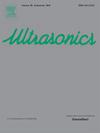A damage identification method for aviation structure integrating Lamb wave and deep learning with multi-dimensional feature fusion
IF 3.8
2区 物理与天体物理
Q1 ACOUSTICS
引用次数: 0
Abstract
With the development of aerospace industry, a more suitable structural health monitoring (SHM) method is urgently needed to solve the problem of multi-dimensional extraction and effective utilization of damage information involved in complex aviation structural sensing signals. This paper proposes a method for identifying damage in aviation structures integrating Lamb wave and deep learning with multi-dimensional feature fusion, which can effectively locate and quantify the damage in aviation structure. Firstly, the Lamb wave signal is excited and received in the real aircraft cutting section. The collected signal is processed in one-dimensional (1D) by extracting the damage index, and two-dimensional (2D) by transforming it into the Gramian angular field (GAF), respectively. Then a deep learning model with multi-dimensional feature fusion is established, which includes two neural network branches, namely 1D branch network and 2D branch network. Among them, 1D branch network includes multi-scale convolution Inception-v1 module and Bi-directional long short-term memory (BiLSTM) layer, and 2D branch network includes continuous convolution module and BiLSTM layer. The extracted 1D and 2D damage information is fused and learned to further enhance its spatial and temporal representation ability. Finally, the transfer research across geometric sensor arrays is attempted. The test results show that this method effectively locate and quantify the single-source offset damage and multi-source cumulative damage in the aircraft cutting section. Moreover, the model after transfer learning can realize damage identification on different sensor arrays with less training samples and less time, which proves that this method has significant advantages in the accuracy and robustness of damage identification.
求助全文
约1分钟内获得全文
求助全文
来源期刊

Ultrasonics
医学-核医学
CiteScore
7.60
自引率
19.00%
发文量
186
审稿时长
3.9 months
期刊介绍:
Ultrasonics is the only internationally established journal which covers the entire field of ultrasound research and technology and all its many applications. Ultrasonics contains a variety of sections to keep readers fully informed and up-to-date on the whole spectrum of research and development throughout the world. Ultrasonics publishes papers of exceptional quality and of relevance to both academia and industry. Manuscripts in which ultrasonics is a central issue and not simply an incidental tool or minor issue, are welcomed.
As well as top quality original research papers and review articles by world renowned experts, Ultrasonics also regularly features short communications, a calendar of forthcoming events and special issues dedicated to topical subjects.
 求助内容:
求助内容: 应助结果提醒方式:
应助结果提醒方式:


